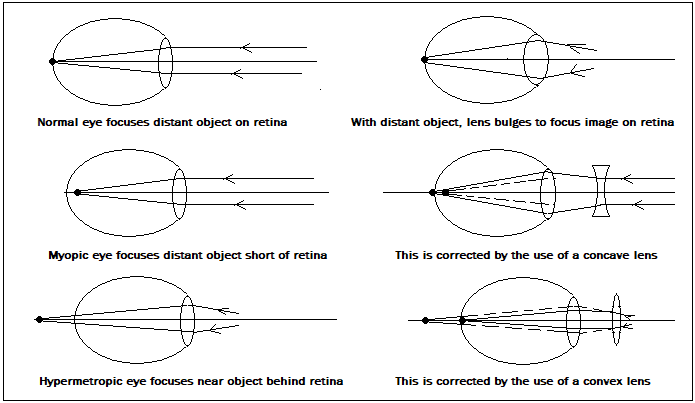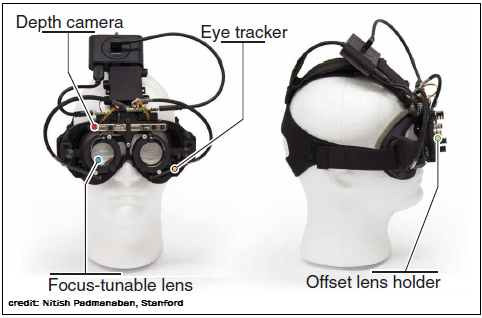Spectacles that change, like the lens of the eyes, is the next step in sight correction, says S.Ananthanarayanan.
Human sight is known to get less efficient with age. Perhaps this happens with animals as well, but humans have devised technology to correct deficiencies, and manage quite well for most of their lives. Current methods, however, are different for near vision and distant vision, and may need to be switched when we shift out gaze from one object to another.
Nitish Padmanaban, Robert Konrad and Gordon Wetzstein, from Stanford University, report in the journal, Science Advances, an arrangement that does better, it detects what a person is looking at and does an autofocus, or modifying the lenses of her spectacles to be just right for that distance. A large proportion of users who tried out the device found the result to be better that the best that we have so far, the paper says.
The sense of vision has its origin in the earliest organisms, which could just detect light or shade, and evolved, through the ages, to organs that could focus light as an image. The modern eye, with its high degree of clarity and acuity, consists of a lightproof chamber with a light-sensitive screen and a lens whose focus can be adjusted. The cavity of babies' eyes is a little shorter than adults' and babies, at the start, are not able to focus on near objects. But baby eyes have flexible lenses and they soon learn to perceive, and grasp, near things. The problem recurs when the baby grows much older and the lens is less flexible. And at this stage, she needs a concave lens in her spectacles to be able to read the newspaper.
The picture shows the way the normal, young person's eyes function. The relaxed lens focuses the image of a distant object on the retina, the light-sensitive screen at the far end of the eye chamber. When the object moves closer, the same state of the lens would focus the image a little behind the retina and the image would be blurred. The muscles of the eye adjust for this by making the lens bulge a little more and bring the point of focus nearer, so that the image is again on the retina.

If the lens, in the relaxed position, focuses the image short of the retina, as in the second row in the picture, distant objects appear blurred. With nearer objects, however, the image moves a little back and is seen clearly. A person with this condition, which is known as myopia, needs to strain the eye to reduce the bulge of the lens and move the point of focus closer to the retina. The condition is usually treated by placing a concave lens, one that makes light rays diverge, before the eyes.
The opposite of myopia is long sight, or hypermetropia, where distant objects are clear, but near objects are blurred. This happens with older people, where the crystalline material of the eye is not flexible and the lens cannot focus light on the retina, but forms the image behind the retina. The solution is then to place a convex lens, which makes the rays of light converge, in front of the eyes, so that the point of focus moves forward.
With advancing age, there is usually an element of both myopia as well as long sight. A person hence needs a pair of lenses for normal use and another pair for near-range work, such as reading. The inconvenience is avoided if we combine both kinds of lenses, in the bifocal. This is just a split lens, the upper part is concave, for seeing distant things, and the lower part is convex, for reading.
The disadvantage, however, is that the field of view is broken, there are double images and the user could misjudge heights, to trip and fall. An improvement of the bifocal was the progressive, where the concave and convex curvatures are built into a single lens, with a smooth changeover. The improvement, however, is partial.
"The common thread across these methods is that they use fixed focal elements to approximate vision that was once achieved by the flexible crystalline lenses in the wearer’s eyes," the paper in Science Advances says. In the absence of a method to reverse the stiffening of the material of natural lens material with age, one method tried was to create a 'variable focus' lens, to be placed in front of the eyes, just like the fixed focus lenses now used.
An early version of this lens was the Alvarez lens, where there are two thin lens elements, which can slide over each other, as shown in the picture. The patent application for the Alvarez lens said that a movement of 2.5 mm, could bring about a change in the power, by as much as 3 diopters (diopter is the 'number' that opticians use). As a movement of 2.5 mm can be accommodated in normal spectacle frames, it said, the arrangement could easily change from distant to near settings in most cases.

Other methods have been to use liquid lenses that can change shape, and arrangements to discover the distance of objects in front of the person, to adjust the lens. Most of these methods, however, the Scientific Advances paper says, usually need some form of manual control and were never really as good as a young person's ability to effortlessly see clearly objects at different distances, as fast as she turns her head around. The use of the depth sensor, which could automate control of the shape of the lens, the paper notes, is an advance, but it requires the wearer to turn her head and face the object that she wishes to see. The method also breaks down when viewing transparent or moving objects, or through a window, or when people pass in front of the object. Methods used in Virtual Reality, based on tracking eye movements have also shown promise, the paper says.
As an ideal solution is still not in sight, the Stanford University trio constructed a prototype wearable spectacles system that combines electronically controlled liquid lenses, a stereo camera to assess depth over a wide field of view and an arrangement to track the movements of the eye, to know where they are looking. While the eye tracking system senses where the eyes are pointed, the stereo camera estimates the distance of the object being viewed and passes a signal to the lenses, which automatically adjust their focal power. All the major deficiencies of existing systems are thus addressed.

The authors write that a large sample of users tried out the system and compared the results with other methods, starting from bifocals, progressives, or more sophisticated solutions. " ..we find that focus-tunable eyeglasses, on average, outperform traditional forms of correction across a range of metrics. ....users wearing autofocals express a notable preference for our eye-tracked autofocals over a previously proposed depth-tracked solution..." the authors note.
Helping the elderly get around
As age progresses, the sense of balance and sensations of pressure, pain or warmth deteriorate and humans need to rely more heavily on their sense of sight. It is unfortunate that in this sense too, the capacity of accommodation, or the capacity of the eye to adjust to view objects at different distances, reduces with age.
Developing a device that automatically senses the distance of an object being viewed and compensates for deficiency of the eyes in viewing that object would go a long way helping older people get around more safely.------------------------------------------------------------------------------------------ Do respond to : response@simplescience.in